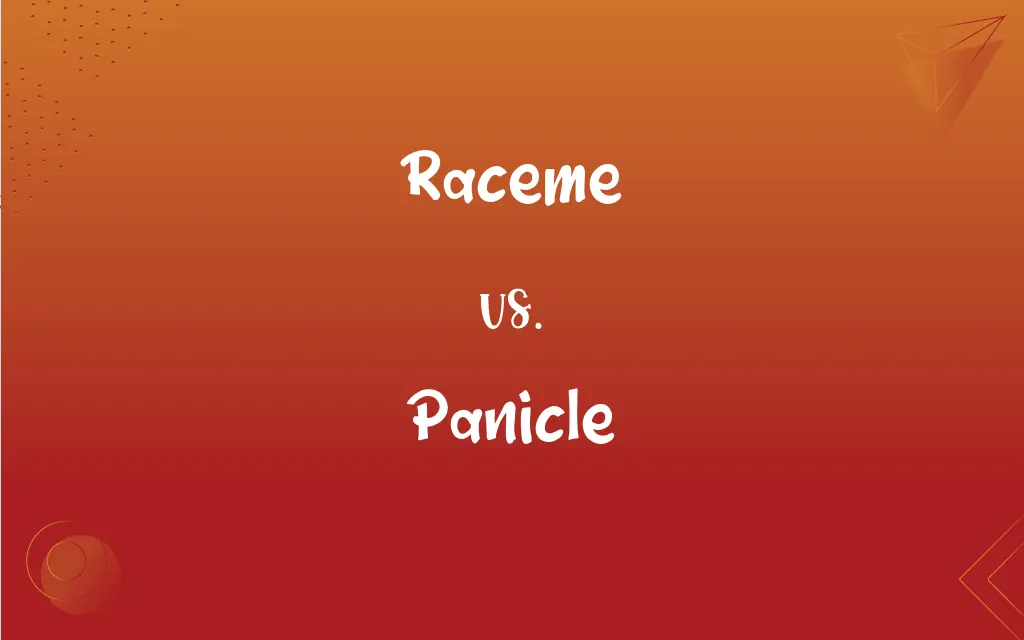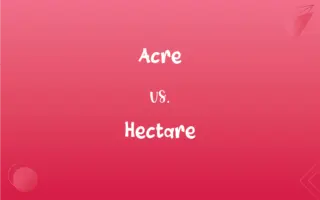Raceme vs. Panicle: What's the Difference?
By Janet White & Harlon Moss || Updated on March 4, 2024
A raceme is a type of flower arrangement where flowers are attached by short equal stalks at equal distances along a central stem, while a panicle features a branched cluster of flowers with flowers on branches of different lengths.

Key Differences
Raceme and panicle are both terms used to describe types of inflorescences, which are the arrangements of flowers on a plant. The key difference between them lies in their structure and the way the flowers are arranged on the main axis.
In a raceme, the arrangement is simple and linear, with each flower attached directly to the central stem (the rachis) by its own short stalk, known as a pedicel. This results in a uniform, ladder-like appearance. Can concoctions be harmful if not prepared correctly?
Yes, concoctions can be harmful if ingredients are not properly chosen or mixed, especially in medicinal or chemical contexts where incorrect dosages or combinations can lead to adverse effects.
How does the concept of a mixture apply to everyday life?
The concept of a mixture applies to everyday life in various ways, from the air we breathe (a mixture of gases) to the foods we eat (mixtures of different ingredients).
ADVERTISEMENT
Is coffee considered a mixture or a concoction?
Coffee can be considered both a mixture (water and coffee grounds) and a concoction, especially when specific ingredients are added to achieve a particular flavor or effect.
What is the significance of temperature in preparing concoctions?
Temperature can play a critical role in preparing concoctions, affecting the solubility of ingredients, the rate of chemical reactions, and the overall taste or efficacy of the concoction.
How do you determine the right proportions for a concoction?
ADVERTISEMENT
Determining the right proportions for a concoction often involves research, understanding of the ingredients' properties, trial and error, and sometimes adherence to traditional or established recipes.
Can a mixture become a concoction over time?
Yes, a mixture can become a concoction if it is modified or used with a specific purpose in mind, transforming it from a simple combination of ingredients to a purposefully created blend.
What ethical considerations are involved in concocting medicines?
Ethical considerations in concocting medicines include ensuring safety, efficacy, informed consent, and access to treatment, as well as avoiding harm and respecting patient autonomy.
How do sensory properties affect the perception of a concoction?
Sensory properties like taste, smell, and texture significantly affect the perception of a concoction, influencing its acceptability and enjoyment, especially in culinary applications.
What challenges do scientists face when creating concoctions for new treatments?
Scientists face challenges such as ensuring safety and effectiveness, regulatory approval, ethical considerations, and sometimes the unpredictability of how different ingredients interact.
How has the understanding of mixtures and concoctions evolved over time?
The understanding of mixtures and concoctions has evolved with advances in chemistry, medicine, and technology, leading to more precise knowledge of how substances interact and how to harness these interactions for various purposes, from cooking to curing diseases.
While both racemes and panicles serve the same fundamental purpose of organizing flowers for optimal reproductive success, their structural differences reflect adaptations to their specific ecological niches and pollinator interactions. Racemes, with their simpler design, can facilitate easy access for pollinators to sequentially blooming flowers. Panicles, with their complex branching, can attract a wide array of pollinators and support a larger number of flowers.
The distinction between racemes and panicles is not just botanical nuance but reflects broader ecological strategies. Understanding these differences can enhance appreciation of plant diversity and the intricate ways in which plant forms are tailored to their reproductive and survival strategies.
Comparison Chart
Structure
Simple, linear arrangement with flowers on short, equal stalks along a central stem.
Branched, with flowers on branches of varying lengths.
Appearance
Uniform and ladder-like.
Voluminous and bushy.
Flower Attachment
Direct attachment of flowers to the main stem via pedicels.
Flowers attached to branches, which then connect to the main stem.
Complexity
Less complex, with no branching apart from the central stem.
More complex due to branching patterns.
Example Plants
Lupines, certain mustard family members.
Oats, rice, some grass family species.
Flowering Sequence
Sequential blooming from the bottom upwards.
Diverse blooming sequence due to branching.
Pollinator Interaction
Facilitates easy access for pollinators to flowers.
Attracts a wide array of pollinators with its structure.
Raceme and Panicle Definitions
Raceme
The structure of a raceme simplifies pollinator access.
The raceme arrangement of the pea plant aids in efficient pollination.
Panicle
A panicle features a complex, branched structure of flowers.
The panicle of the oat plant spreads out, bearing numerous flowers.
Raceme
Each flower on a raceme has its own stalk.
In a raceme, the individual stalks create a uniform spacing between flowers.
Panicle
Panicles are characteristic of various grasses.
Many grass species, including decorative grasses, display flowers in panicles.
Raceme
Racemes are common in certain plant families.
Many plants in the Brassicaceae family feature flowers arranged in racemes.
Panicle
The panicle's design attracts diverse pollinators.
The branched structure of a panicle on a lilac bush appeals to bees and butterflies.
Raceme
A raceme is a straightforward flower arrangement along a central stem.
The raceme of the lupine displays its purple flowers in a neat row.
Panicle
Panicles can carry more flowers due to branching.
The rice plant produces a dense panicle filled with grain-bearing flowers.
Raceme
Flowers in a raceme bloom sequentially.
The raceme of the foxglove ensures continuous blooming as each flower opens in turn.
Panicle
Flowers in a panicle may bloom at different times.
The panicle's branching allows for a prolonged flowering period.
Raceme
An inflorescence having stalked flowers arranged singly along an elongated unbranched axis, with the flowers at the bottom opening first.
Panicle
A loosely branched inflorescence, especially a branching raceme.
Raceme
(botany) An indeterminate inflorescence in which the flowers are arranged along a single central axis.
Panicle
(botany) A compound raceme.
Raceme
A flower cluster with an elongated axis and many one-flowered lateral pedicels, as in the currant and chokecherry.
Panicle
A pyramidal form of inflorescence, in which the cluster is loosely branched below and gradually simpler toward the end.
Raceme
Usually elongate cluster of flowers along the main stem in which the flowers at the base open first
Panicle
Compound raceme or branched cluster of flowers
FAQs
What is a raceme?
A raceme is a type of inflorescence characterized by a linear arrangement of flowers, each attached by a short stalk to a central stem.
Why might a plant develop a raceme instead of a panicle?
A plant might develop a raceme to facilitate easier access for pollinators to sequentially blooming flowers, optimizing pollination efficiency within its ecological niche.
What is a panicle?
A panicle is a branched, flowering structure where flowers are arranged on branches stemming from the main axis, with each branch potentially further branching out.
What advantages do panicles offer to plants?
Panicles can support a larger number of flowers and attract a wider range of pollinators due to their complex and visually appealing structure.
Are racemes or panicles better for attracting pollinators?
The effectiveness in attracting pollinators can depend on the plant's environment and the types of pollinators it aims to attract; both structures have their advantages.
How do racemes and panicles differ in appearance?
Racemes appear more uniform and ladder-like due to their simple, linear arrangement, while panicles are bushier and more voluminous due to their branched structure.
Can both racemes and panicles be found in the same plant family?
Yes, both types of inflorescences can occur within the same plant family, reflecting the diversity of flowering strategies within that family.
What role do racemes and panicles play in ecosystem diversity?
These flowering structures contribute to ecosystem diversity by supporting varied pollination strategies, which in turn supports a diverse array of pollinators and other plant species.
How does climate affect the development of racemes and panicles in plants?
Climate can influence the timing and development of racemes and panicles, with temperature, humidity, and seasonal changes affecting flowering patterns and the success of pollination.
Can the arrangement of flowers in racemes and panicles impact seed dispersal?
Yes, the arrangement can affect seed dispersal mechanisms. For example, the positioning of flowers in racemes and panicles can influence how seeds are released and spread by wind, animals, or other dispersal agents.
How do gardeners use knowledge of racemes and panicles?
Gardeners use this knowledge to select plants that will create desired visual effects in landscapes and to understand the pollination and care needs of different plants.
Do racemes and panicles require different care in a garden setting?
Care requirements can vary based on the plant's overall needs rather than the type of inflorescence. However, understanding the structure can help in managing space, sunlight exposure, and supporting structures for optimal growth.
Can the structure of a raceme or panicle affect a plant's reproduction?
Yes, the structure can significantly impact reproduction by influencing pollinator behavior, flowering sequence, and therefore, the plant's overall reproductive success.
How do racemes and panicles affect the aesthetic appeal of plants?
The distinct appearances of racemes and panicles contribute to the aesthetic diversity of gardens and landscapes, with racemes offering linear elegance and panicles providing lush volume.
Are there any specific pests or diseases that target racemes and panicles?
While pests and diseases can target any part of a plant, certain ones may be drawn to dense inflorescences like panicles or may exploit the exposed nature of racemes. Regular monitoring and appropriate care are essential for prevention.
Can the presence of racemes or panicles indicate the health of a plant?
The health and vigor of inflorescences, including racemes and panicles, can reflect the overall health of the plant, with robust flowering often indicating good growing conditions and vitality.
What evolutionary advantages do racemes and panicles offer to plants?
These inflorescence structures may offer evolutionary advantages by optimizing pollination success through increased exposure to pollinators, efficient use of space, and adaptation to environmental conditions.
How do racemes and panicles interact with their pollinators?
The structure of racemes and panicles can facilitate interactions with specific pollinators by providing accessible or appealing arrangements of flowers, thereby enhancing pollination efficiency.
What research is being done on racemes and panicles?
Research on racemes and panicles includes studies on their development, genetic control, ecological interactions, and evolutionary significance, aiming to understand how these structures influence plant reproduction and survival.
How do racemes and panicles contribute to the biodiversity of an ecosystem?
By supporting different pollinators and serving various reproductive strategies, racemes and panicles contribute to the genetic diversity and resilience of plant populations within ecosystems.
About Author
Written by
Janet WhiteJanet White has been an esteemed writer and blogger for Difference Wiki. Holding a Master's degree in Science and Medical Journalism from the prestigious Boston University, she has consistently demonstrated her expertise and passion for her field. When she's not immersed in her work, Janet relishes her time exercising, delving into a good book, and cherishing moments with friends and family.
Co-written by
Harlon MossHarlon is a seasoned quality moderator and accomplished content writer for Difference Wiki. An alumnus of the prestigious University of California, he earned his degree in Computer Science. Leveraging his academic background, Harlon brings a meticulous and informed perspective to his work, ensuring content accuracy and excellence.
































































